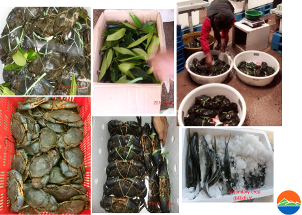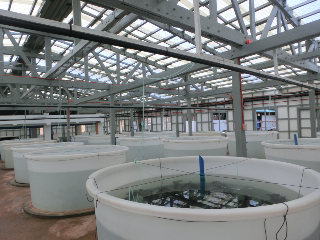
Originally engaged in producing and culturing high-value marine aquatic species, the Palawan Aquaculture Corporation (PAC) based in Baguid, Coron, Palawan, is now adopting mangrove crab hatchery technology. The technology was developed by the Southeast Asian Fisheries Development Center – Aquaculture Department (SEAFDEC/AQD).
Initial trials on larval rearing of mangrove crab conducted in 2013 at PAC produced only minimal quantity of crablets. In 2014, the mangrove crab hatchery technology developed by SEAFDEC/AQD was adopted by PAC. As part of its capacity building, PAC staff attended the training course on mangrove crab hatchery and nursery operation at SEAFDEC/AQD in Tigbauan, Iloilo. It was followed by an onsite technical assistance of SEAFDEC/AQD at PAC headquarters.
In a recent visit to PAC, the team of Dr. Emilia T. Quinitio of SEAFDEC/AQD and Dr. Adelaida T. Calpe, Industry Strategic S&T Program (ISP) Manager for mangrove crab of the Inland Aquatic Resources Research Division (IARRD), Philippine Council for Agriculture, Aquatic and Natural Resources Research and Development of the Department of Science and Technology (DOST-PCAARRD), assessed the extent of PAC’s hatchery technology adoption. Production records showed significant improvement in the production of crab instars which were grown further in the net cages installed in nursery ponds for Phases 1 and 2 nursery activities.
Survival rates in the hatchery and nursery ranged from 8-10% and 44-68%, respectively. Crab juveniles measuring >2 cm carapace width (CW) were either sold or stocked in grow-out ponds with milkfish until stocks reached marketable size. At harvest, milkfish (approximately two pieces at one kg) were sold to local restaurants and markets in Coron at a farm gate price of P130/kg. Likewise, crabs were sold at P750/kg.
With the success in the adoption of the technology, a bigger hatchery with minimum production capacity of 25,000 crablets/instars achievable in 24 days was constructed. The hatchery aims to commercially produce marketable-sized crabs and while addressing the growing demand for crablets in the industry by selling excess instar stages and crablets to existing growers inside and outside Palawan. To date, PAC has sold crablets to the Food and Agriculture Organization (FAO) Livelihood Enhancement Project in Palawan and in other areas such as Batangas and Bataan.
 In spite of the negative impacts of El Niño phenomenon, particularly high water temperature and salinity which affected the larval rearing activities in the hatchery, PAC continues to regularly produce crablets as it has been doing in the past months through specific S&T interventions. This development is a clear indication that the existing mangrove crab hatchery technology is viable and DOST-PCAARRD’s ISP target of 5% survival rate is attainable.
In spite of the negative impacts of El Niño phenomenon, particularly high water temperature and salinity which affected the larval rearing activities in the hatchery, PAC continues to regularly produce crablets as it has been doing in the past months through specific S&T interventions. This development is a clear indication that the existing mangrove crab hatchery technology is viable and DOST-PCAARRD’s ISP target of 5% survival rate is attainable.
The National Mangrove Crab (formerly Mud Crab) Program was initiated in 2011 by DOST and DOST-PCAARRD. It was implemented at SEAFDEC/AQD, Tigbauan, Iloilo under the leadership of Dr. Quinitio as Program leader. The program aimed to increase the survival rate of mangrove crab in the hatchery and promote the technology to potential private sector adopters.
The hatchery technology for mangrove crab, along with DOST-PCAARRD’s leading R&D initiatives in the agriculture, aquatic, and natural resources (AANR) sectors, will be featured during the National Science and Technology Week (NSTW) on July 25-29 at the Council’s complex. This year’s NSTW adopts the theme, Juan Science, One Nation.
The Council will also celebrate its fifth anniversary on July 28, 2016. This will highlight the conduct of the National Symposium on Agriculture and Aquatic Resources Research and Development (NSAARRD) in the morning and awarding of papers in the afternoon. The NSAARRD showcases the most outstanding contributions of individuals and institutions in improving the state of the AANR sectors through research and development.
